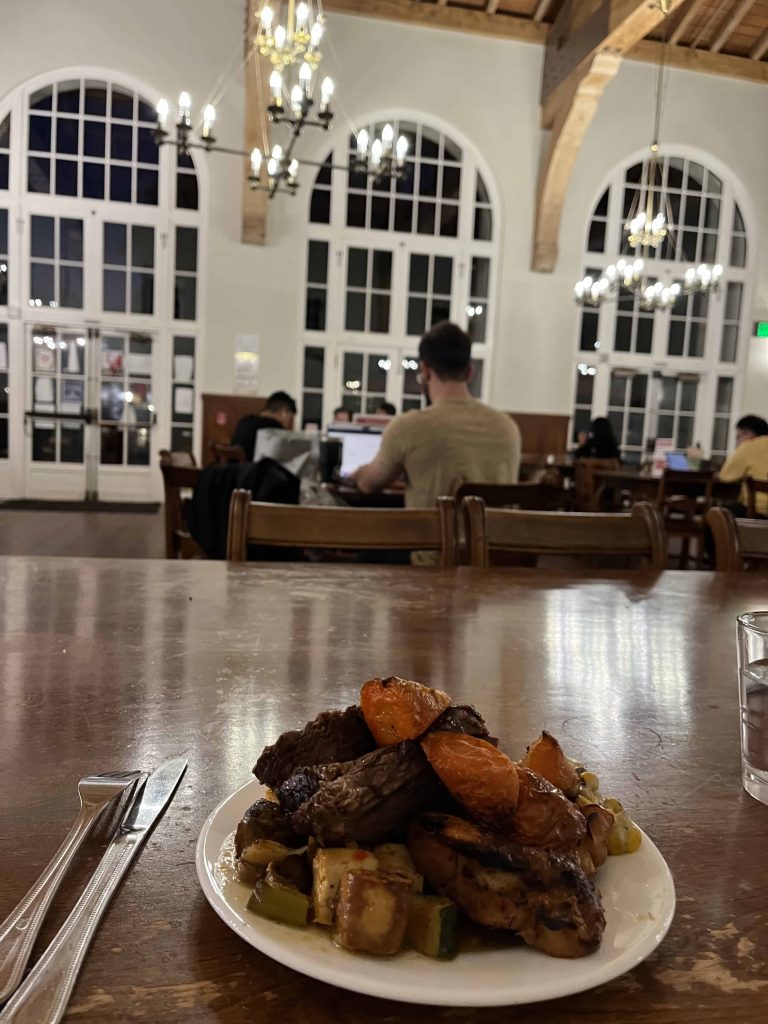I’ve just wrapped up my first quarter at Stanford, which is crazy to think that I’m 1/12th of the way done with college! As I was coming home for winter break, I was reminded of my life just a year ago—frantic with college applications, panicking over college interviews, and ultimately, which college I was going to choose. From being in college now, I’m realizing that there’s so many factors to choosing a college that just seemed like a vague idea before, but are now my reality. For example, how do rankings actually matter? What does “emphasis on undergraduate teaching” actually mean? A year ago, these factors seemed like just a vague idea to me. Like, how do I choose if I value “undergraduate teaching” or “school vibes”? So in honor of college decisions for this year’s graduating class (seniors, this is for you!), here are some of the most important aspects when choosing a college that I’ve learned from my first year in college!

1. Yes, School Size is a Big Differentiating Factor
Unless you went to one of those crazy big high schools in New York City, your high school likely didn’t exceed 2,000 people. Yet, a small college is considered a school with less than 5,000 people, which makes it difficult to tell what size school you would like best. For me, I had a vague idea that I preferred a large enough school where everyone wouldn’t know each other’s gossip all the time, but small enough where I wouldn’t be lost in the crowd. In the end, I mostly applied to medium (5,000-15,000 students) and small colleges (less than 5,000 students). Stanford is a medium sized school with an undergraduate population of around 8,000 students, which to me, is a perfect size. It’s big enough that people won’t be in each others’ business all the time, but small enough that you can run into the same people with some frequency, so it’s not like UCLA or other large state schools where you will never see the same person again unless you keep in contact.
I’ve also found that large schools often have similar or more resources, even compared to Stanford, but just diluted over more students. For example, the University of Washington often has similar or comparable programs to Stanford, but because it has over 5x the number of students, there’s just 43,000 students vying for the same resources compared to 8,000 at Stanford. You can search up the endowment per student, which is a bit like GDP per capita. It doesn’t necessarily mean better facilities though, because I can tell you, my friends at state schools have much better dorms than my dorm at Stanford.
If I really were to look back now, I would probably have advised myself to apply to less small schools. As I mentioned in my college decisions post, as wonderful as the school is, I knew immediately after visiting Harvey Mudd that I really did not like the small college feel. I would much prefer to go bigger than to go to a small school, so I would advise myself not to apply to the small, liberal arts colleges that I did, and rather, apply to more large, state schools. So in total, my advice? College visits do matter as it helps you get a feel of the campus, and if you feel suffocated or lost by the size of the campus, that can tell you a bit about what size school you would prefer.
2. Does Prestige Matter?
When I was choosing schools, I felt guilty if I considered a school’s rankings in my decisions, as I didn’t want to be just chasing prestige. But now, I’ve realized prestige is much more than just a fuzzy, feel-good thing when you get to say where you go to school. Instead, it actually makes a difference when you’re trying to make connections. At Stanford, everyone tells you that your Stanford email gets you very far. Want to cold email someone? They’re usually more likely to reply if they see a “stanford.edu” compared to an email address they’ve never heard of. When you say you go to Stanford, it usually requires no explanation, and that’s actually a pretty significant step-up when you get an automatic positive association because of your school’s brand name. Of course, once you delve deeper than just the surface level, people aren’t going to give you things because you have a “stanford.edu” email address, but it can help you get your foot in the door.
Because of this, the advice I’d give regarding prestige is to look at global rankings, rather than some niche rankings, especially if you’re hoping to go international in your career. The specific rankings sometimes don’t actually play out in the real world. For example, if you tell your grandma you go to the University of Alabama, she probably recognizes the “Alabama” and understands it’s a well-respected school in a U.S. state, while she might not recognize a top school like Bowdoin. Of course, the point of this isn’t to say that you should just choose the most highly ranked school globally. My point is that unless it’s a school within the top 20 or has a state name, it’s probably not that big of a difference. If you’re considering the prestige of a school by name recognition, the specific rankings don’t necessarily represent the whole truth of how many people will recognize your school in the future.
3. Should You Choose Program Strength or Overall School Strength?
When I was in high school, I was very set on what I wanted to do. I had a whole life and career planned out, and I thought that was exactly what I was going to pursue in the future. But the second I stepped foot in college, I suddenly realized there were many more options than I thought were possible. So, as someone who was like, “I’m probably not going to change my major,” in the short span of one quarter, I have considered switching my major from Bioengineering to Archeology to Computer Science to Chemistry, and who knows what else. Because of this, one of the greatest realizations I’ve had is to be wary of choosing a school for its strength in a single program. For example, if you choose a school for its computer science program but then decide to switch out, you’re pretty much stuck if your school isn’t that great in the other major you choose. As certain as you might be about your major, just know that college can change your mind.
One of the aspects I appreciate most about Stanford is its strength in a variety of programs. Whether it was my brief stint in considering becoming an Archeology major or switching to some variation of computational biology for the hundredth time, Stanford was usually still ranked very highly in whatever I was interested in. If you’re not 100% certain on your major and feel an inkling of exploration, a school with overall better programs might be a better fit than a school that’s only strong in one program.
4. “Vibes”—Should You Care About the Stereotypes?
Vibes were surprisingly a big deal for me—I read lots of forum threads and online posts about the “vibes” at different schools, where I learned that Stanford had duck syndrome and startup culture, Johns Hopkins was full of cutthroat, toxic premeds, and Brown was very laid-back and liberal. This was very high on my list of priorities, until I talked to a college student, and he told me he chose his school because he liked the parties and drinking culture at his school. At that point, I realized that 18-year olds could not be trusted to make decisions about culture.
In all seriousness though, stereotypes are just that—they hold some element of truth, but in general, with thousands of people at a school, it’s impossible for everyone to be the exact same. You can find your own niche within a school with any stereotype of culture. Depending on the pervasiveness of the stereotype, it might take some time to find your people, but in general, you can find people with a variety of interests in college. In the end, I don’t think I exactly fit in with the startup culture at Stanford, but I’ve had no trouble not being a part of it and finding my own people. I would also note that I find Stanford to be very collaborative, and not cutthroat at all. I took General Chemistry this quarter, which is well-known as a pre-med weedout class, and it has been one of the most collaborative classes I have ever taken with the kindest and most dedicated people ever.
5. What Does Undergraduate Experience and Undergraduate Teaching Mean?
Some schools, like Dartmouth, Amherst, and other liberal arts colleges pride themselves on undergraduate teaching, and that was always confusing to me. Because I mean, of course I want a good undergraduate experience! But, how much does the ranking of “undergraduate teaching” actually matter?
“Good” teaching is subjective. I’ve had professors that I really liked, while other students disliked, and vice versa. In addition, I found that classes itself are not as important as I thought. Today, you can take pretty much any class you want online, so the value of taking a class is in the interaction with professors, TAs, and getting to ask questions. In total, the lectures aren’t that big of a deal—it’s the faculty you interact with, and that becomes a question of whether you value (1.) faculty—doing cool and interesting work on campus, or (2.) faculty focused on students, mentorship, and answering questions. If you value the first one, look at schools ranked highly in global prestige and research output. The second one is what undergraduate teaching refers to, which allows you to make the most out of it by asking lots of questions in class and getting mentorship from faculty. It all depends on your learning style. Since I prefer a more hands-off and independent approach to learning, I’d choose research over undergraduate teaching. While I can’t say I’ve taken classes at more undergraduate-focused schools, I’ve found my classes at Stanford to be pretty high-quality and I’ve gotten the support and instruction I needed.
Also, many undergraduate-focused schools don’t have graduate schools on campus. However, I personally prefer having graduate students on campus. Stanford has several graduate schools, which makes for a much more interesting environment, as I get to interact with students from different backgrounds and attend events that aren’t just for undergraduates. There are some events on campus for graduate students or medical school students that I’ve attended just because I wanted to, and they help broaden my horizons of the work that’s possible at different stages of my career.
6. Does Academic Rigor and Grade Inflation Matter?
While all colleges are rigorous academically, some are known for being more cutthroat or “weedout” than others—often at large state schools, like UC Berkeley. This was a big reason for my preference against large state schools in the beginning. In comparison, lots of private schools like the Ivy League or Stanford are known for having more grade inflation. To me, I don’t necessarily think that’s been super true. I’ve still had to work really hard for my classes (way harder than I ever did in high school), and sometimes, the grade I got didn’t necessarily reflect the amount of effort I put in. However, I considered my high school very, very grade inflated, so in comparison, I’ve had to put in way more work for my college classes than in high school. For my friends from my high school that go to state schools, there’s also a similar feeling of having to work harder in college, so overall, I wouldn’t say the reputation of a school’s difficulty should be regarded as how “easy” or “hard” a school is. If you go to an academically rigorous school, no matter where you go, you’ll inevitably stress over finals and exams at some point. If you get in, you’re already academically qualified to be there, and it’s a matter of figuring out the balance between your academics at that point. Even if Stanford is grade inflated, it definitely isn’t easy.

7. Does It Matter If the Dorm and Food Sucks?
I know it seems like food and housing might be trivial considerations—until you realize, yeah, you’re living there for the next four years. In my opinion, the quality of food and housing won’t determine your college experience, but it can just be either a source of complaints or satisfaction. If you have a great dining hall and a nice, spacious dorm, then it’ll feel like a nice hotel stay. If you have a terrible dining hall and communal bathrooms, you’ll complain to your friends every once in a while, but you’ll get over it. It really shouldn’t dictate your college choice, but one important consideration is guaranteed housing. Check if your college guarantees housing for four years, because if not, you have to check the housing prices near the area to see if you’ll be able to afford decent housing once you move into apartments later on.
At Stanford, I would say the dining halls in general are pretty good. Our standard dining plan is 15 meal swipes a week with $300 worth of meal plan dollars, which averages to around two meals a day. As someone who eats breakfast everyday, I’d say it’s manageable with a combination of free food on campus and using my meal plan dollars when I run out of meal swipes. The first week feels incredibly exciting, as you have an endless all-you-can-eat buffet every single day. However, by the end, it does get pretty repetitive since they repeat around the same menu every week, and you’ll start missing home-cooked meals. While some dining halls just offer fried foods, pizza, and fries, Stanford’s dining hall is also fairly healthy, and usually offers one or two protein options (usually chicken) with roasted or steamed vegetables. I almost always eat on campus though, because there aren’t really many accessible restaurants near Stanford, and Palo Alto is quite a walk away.
As for the dorms, most underclassmen dorms are one room or two room doubles. It’s decently spacious, although my biggest complaint is with the communal bathrooms and lack of private study spaces. I’ve also stayed at the dorms at MIT, and I think the Stanford dorms are comparable to MIT, but the dining hall is way better. In general, it’s not bad—I only complain about it if I’m in a bad mood.
So, did I make the right choice in my college decision?
And the verdict is… I’m happy with my choice to attend Stanford! If you were to ask me my top values now when choosing a college, I would say its international reputation, size, and diversity of programs. A year ago, I would’ve said vibes, program strength for my major, and academic rigor. While my values for my college choice have changed, I think Stanford ended up fitting perfectly for what I wanted from my college experience.
Firstly, it’s undeniable that Stanford has a strong reputation. At Stanford, I’ve randomly stumbled upon the most obscure topics, just to find out that Stanford is ranked one of the best in the world in whatever it is. Because of its overall strength in all different programs, Stanford provides a sense of exploration that allows me to truly explore all aspects of my interests, whether that’s entrepreneurship, tech, medicine, or public service, at a world-class level. I also only started noticing the importance of the “brand name” when I came to Stanford, as I have definitely benefitted from the Stanford association when finding and applying for opportunities.

As for the social scene and environment at Stanford, I learned that while stereotypes about a school usually do provide some indication of the environment and “vibes” of the student body, it’s not really as important as you might think, especially if you go to a decently large school. Sure, Stanford might have the stereotype of being a “tech bro” startup culture school, but in reality, you can find whatever group of people you want to associate with on campus. If the tech bro, startup culture vibe is what you enjoy, you can find your people, but if not, you can find a diversity of other people as well. Stanford is known as “Nerd Nation,” and while I originally thought that was just for marketing purposes, I feel like it’s a place where geeking out about something is cool—and to me, that’s what I love about the community at Stanford. I find it to be a very accepting community where I’ve felt the freedom to be whatever I want, whether that’s going out or staying in depending on what I feel like, or pursuing a hobby I’m interested in.
While I had expected to refine my interests in college, I haven’t been able to do that—but in a good way. Coming in, I had a pretty clear idea of what I wanted to do in the future. However, because Stanford is so rich in resources, opportunities, ideas, and things to try, I started realizing that there’s much more out there than I ever expected. There’s just so much to do and try, which has been a key aspect of my Stanford experience to be in a place that’s so rich in resources and opportunities in everything I want to do. There’s so much more I could say about my experience, but overall, I’ve grown quite fond of Stanford, and my verdict is that I really like it here.
But what are the downsides? My biggest complaint is the location. I mentioned this in my college decisions post, but I’m very much a big city, downtown girl, so coming to California, I didn’t enjoy the Palo Alto suburbia and lack of public transportation. The Stanford bubble is very real—it’s incredibly difficult to get off campus. Stanford is known famously for being located in a very suburban area, so I knew this beforehand, but the several-hour-long trips just to buy a bottle of shampoo only became a reality when I started living here. However, ultimately, if my primary complaint about my school is the fact that it’s located in California, that’s a pretty good trade-off to have.



